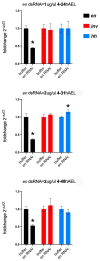Functional Divergence of the Tribolium castaneum engrailed and invected Paralogs
- PMID: 37623401
- PMCID: PMC10455198
- DOI: 10.3390/insects14080691
Functional Divergence of the Tribolium castaneum engrailed and invected Paralogs
Abstract
Engrailed (en) and invected (inv) encode paralogous transcription factors found as a closely linked tandem duplication within holometabolous insects. Drosophila en mutants segment normally, then fail to maintain their segments. Loss of Drosophila inv is viable, while loss of both genes results in asegmental larvae. Surprisingly, the knockdown of Oncopeltus inv can result in the loss or fusion of the entire abdomen and en knockdowns in Tribolium show variable degrees of segmental loss. The consequence of losing or knocking down both paralogs on embryogenesis has not been studied beyond Drosophila. To further investigate the relative functions of each paralog and the mechanism behind the segmental loss, Tribolium double and single knockdowns of en and inv were analyzed. The most common cuticular phenotype of the double knockdowns was small, limbless, and open dorsally, with all but a single, segmentally iterated row of bristles. Less severe knockdowns had fused segments and reduced appendages. The Tribolium paralogs appear to act synergistically: the knockdown of either Tribolium gene alone was typically less severe, with all limbs present, whereas the most extreme single knockdowns mimic the most severe double knockdown phenotype. Morphological abnormalities unique to either single gene knockdown were not found. inv expression was not affected in the Tribolium en knockdowns, but hh expression was unexpectedly increased midway through development. Thus, while the segmental expression of en/inv is broadly conserved within insects, the functions of en and inv are evolving independently in different lineages.
Keywords: Tribolium; engrailed; gene paralogs; invected; segment-polarity; sequential segmentation.
Conflict of interest statement
The authors declare no conflict of interest.
Figures










Similar articles
-
Functional analysis of engrailed in Tribolium segmentation.Mech Dev. 2020 Mar;161:103594. doi: 10.1016/j.mod.2019.103594. Epub 2019 Nov 26. Mech Dev. 2020. PMID: 31778794
-
The evolving role of the orphan nuclear receptor ftz-f1, a pair-rule segmentation gene.Evol Dev. 2013 Nov-Dec;15(6):406-17. doi: 10.1111/ede.12050. Evol Dev. 2013. PMID: 24261442
-
even-skipped acts as a pair-rule gene in germ band stages of Tribolium development.Dev Biol. 2020 Jun 1;462(1):1-6. doi: 10.1016/j.ydbio.2020.03.010. Epub 2020 Mar 13. Dev Biol. 2020. PMID: 32179089
-
[When Tribolium complements the genetics of Drosophila].Med Sci (Paris). 2010 Mar;26(3):297-303. doi: 10.1051/medsci/2010263297. Med Sci (Paris). 2010. PMID: 20346280 Review. French.
-
A genome-wide inventory of neurohormone GPCRs in the red flour beetle Tribolium castaneum.Front Neuroendocrinol. 2008 Jan;29(1):142-65. doi: 10.1016/j.yfrne.2007.10.003. Epub 2007 Oct 24. Front Neuroendocrinol. 2008. PMID: 18054377 Review.
References
Grants and funding
LinkOut - more resources
Full Text Sources
Research Materials

